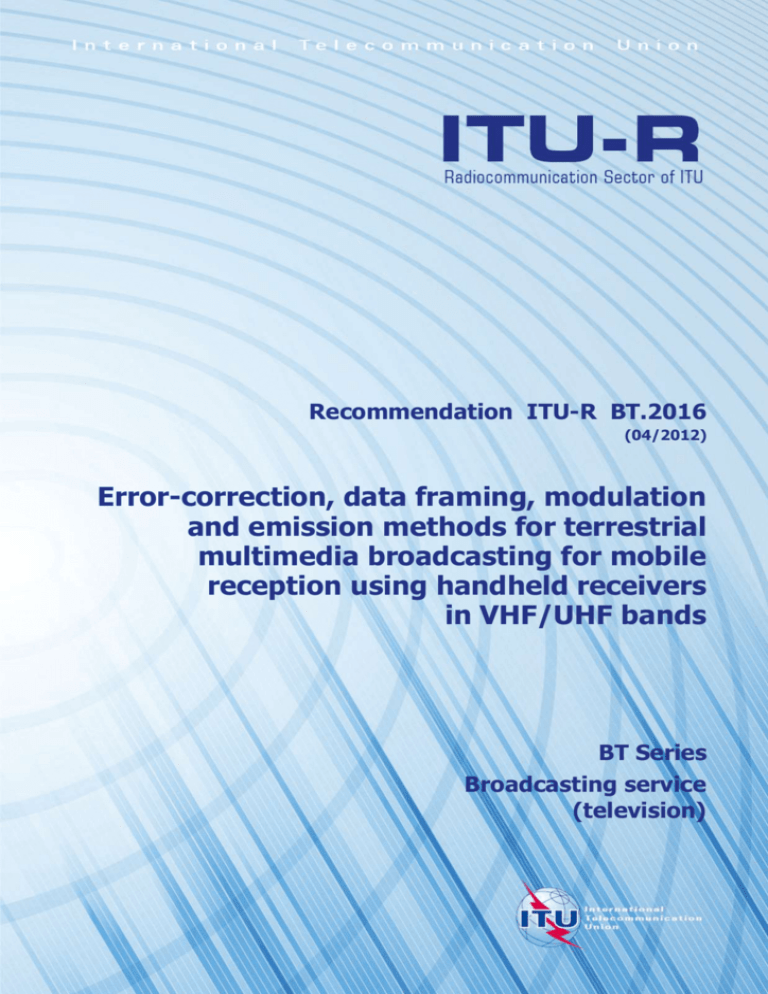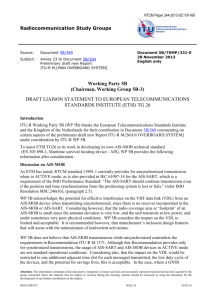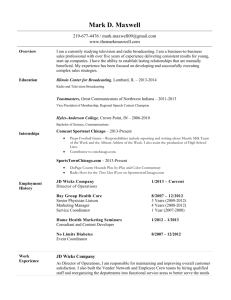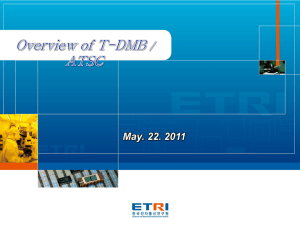
Recommendation ITU-R BT.2016
(04/2012)
Error-correction, data framing, modulation
and emission methods for terrestrial
multimedia broadcasting for mobile
reception using handheld receivers
in VHF/UHF bands
BT Series
Broadcasting service
(television)
ii
Rec. ITU-R BT.2016
Foreword
The role of the Radiocommunication Sector is to ensure the rational, equitable, efficient and economical use of the
radio-frequency spectrum by all radiocommunication services, including satellite services, and carry out studies without
limit of frequency range on the basis of which Recommendations are adopted.
The regulatory and policy functions of the Radiocommunication Sector are performed by World and Regional
Radiocommunication Conferences and Radiocommunication Assemblies supported by Study Groups.
Policy on Intellectual Property Right (IPR)
ITU-R policy on IPR is described in the Common Patent Policy for ITU-T/ITU-R/ISO/IEC referenced in Annex 1 of
Resolution ITU-R 1. Forms to be used for the submission of patent statements and licensing declarations by patent
holders are available from http://www.itu.int/ITU-R/go/patents/en where the Guidelines for Implementation of the
Common Patent Policy for ITU-T/ITU-R/ISO/IEC and the ITU-R patent information database can also be found.
Series of ITU-R Recommendations
(Also available online at http://www.itu.int/publ/R-REC/en)
Series
BO
BR
BS
BT
F
M
P
RA
RS
S
SA
SF
SM
SNG
TF
V
Title
Satellite delivery
Recording for production, archival and play-out; film for television
Broadcasting service (sound)
Broadcasting service (television)
Fixed service
Mobile, radiodetermination, amateur and related satellite services
Radiowave propagation
Radio astronomy
Remote sensing systems
Fixed-satellite service
Space applications and meteorology
Frequency sharing and coordination between fixed-satellite and fixed service systems
Spectrum management
Satellite news gathering
Time signals and frequency standards emissions
Vocabulary and related subjects
Note: This ITU-R Recommendation was approved in English under the procedure detailed in Resolution ITU-R 1.
Electronic Publication
Geneva, 2012
ITU 2012
All rights reserved. No part of this publication may be reproduced, by any means whatsoever, without written permission of ITU.
Rec. ITU-R BT.2016
1
RECOMMENDATION ITU-R BT.2016*
Error-correction, data framing, modulation and emission methods
for terrestrial multimedia broadcasting for mobile reception
using handheld receivers in VHF/UHF bands
(2012)
Scope
This Recommendation defines error-correction, data framing, modulation and emission methods for
terrestrial multimedia broadcasting for mobile reception using handheld receivers in the VHF/UHF bands.
The ITU Radiocommunication Assembly,
considering
a)
that digital multimedia broadcasting systems have been implemented in many countries or
are planned to be introduced, using the inherent capability of digital broadcasting systems;
b)
that terrestrial emission systems for mobile reception using handheld receivers require
specific technical characteristics due to peculiar propagation characteristics;
c)
that the interoperability between multimedia and digital television and sound broadcasting
systems may be desired;
d)
that Recommendations ITU-R BT.1306 and ITU-R BT.1877 specify error-correction, data
framing, modulation and emission methods for digital terrestrial television broadcasting;
e)
that Recommendation ITU-R BS.1114 specifies error-correction, data framing, modulation
and emission methods as well as higher-layer systems characteristics for digital terrestrial sound
broadcasting;
f)
that Recommendation ITU-R BT.1833 describes end user requirements and higher-layer
systems characteristics for multimedia broadcasting systems for mobile reception using handheld
receivers,
recommends
1
that administrations wishing to introduce terrestrial multimedia broadcasting for mobile
reception using handheld receivers in the VHF/UHF bands should use one of the systems
comprising error-correction, framing, modulation and emission methods outlined in Annex 1.
NOTE 1 − Tables 1 and 2 of Annex 1 can be used to evaluate the respective characteristics of the
systems in selecting a specific system.
*
NOTE – The meeting noted that this Recommendation may be updated at the next possible meeting with
the conclusion of additional digital multimedia broadcasting systems.
2
Rec. ITU-R BT.2016
Annex 1
Table 1 provides data about emission systems for terrestrial multimedia broadcasting for mobile
reception using handheld receivers in the VHF/UHF bands. Supplemental information for the
systems can be found in Appendices 1, 2 and 3.
Table 2 provides technical features of each system described in Table 1 that concern several aspects
relevant to implementation and deployment.
TABLE 1
Parameters for emission systems
Parameters
Multimedia System A
Multimedia System F
Multimedia System I
1
Channel
bandwidths
1.712 MHz
1/14 × n of
a) 6 MHz
b) 7 MHz
c) 8 MHz
n ≥ 1 (1)
a)
b)
c)
d)
e)
1.7 MHz
5 MHz
6 MHz
7 MHz
8 MHz
2
Used bandwidth
1.536 MHz
“Subcarrier spacing”
(see item 5) + 1/14 × n ×
a) 6 MHz
b) 7 MHz
c) 8 MHz
n ≥ 1 (1)
a)
b)
c)
d)
e)
1.52 MHz
4.75 MHz
5.71 MHz
6.66 MHz
7.61 MHz
3
Number of
segments
1
n≥1
4
Number of
subcarriers per
segment
192
384
768
1 536
108 (Mode 1)
216 (Mode 2)
432 (Mode 3)
853 (1k mode)
1 705 (2k mode)
3 409 (4k mode)
6 817 (8k mode)
5
Subcarrier
spacing
a)
b)
c)
d)
a) 3.968 kHz
(Mode 1)(2),
1.984 kHz (Mode 2),
0.992 kHz (Mode 3)
b) 4.629 kHz (Mode 1),
2.314 kHz (Mode 2),
1.157 kHz (Mode 3)
c) 5.291 kHz (Mode 1),
2.645 kHz (Mode 2),
1.322 kHz (Mode 3)
a) 1 786 kHz (1k)
b) 5 580.322 Hz (1k)
2 790.179 Hz (2k)
1 395.089 Hz (4k)
697.545 Hz (8k)
c) 6 696.42 Hz (1k),
3 348.21 Hz (2k),
1 674.11 Hz (4k),
837.05 Hz (8k)
d) 7 812 Hz (1k),
3 906 Hz (2k),
1 953 Hz (4k),
976 Hz (8k)
e) 8 929 Hz (1k),
4 464 Hz (2k),
2 232 Hz (4k),
1 116 Hz (8k)
8 kHz
4 kHz
2 kHz
1 kHz
(1)
Rec. ITU-R BT.2016
3
TABLE 1 (continued)
Parameters
Multimedia System A
Multimedia System F
Multimedia System I
a) 252 s (Mode 1) (2),
504 s (Mode 2),
1008 s (Mode 3)
b) 216 s (Mode 1),
432 s (Mode 2),
864 s (Mode 3)
c) 189 s (Mode 1),
378 s (Mode 2),
756 s (Mode 3)
a) 560 µs (1k)
b) 179.2 µs (1k),
358.40 µs (2k),
716.80 µs (4k),
1 433.60 µs (8k)
c) 149.33 µs (1k),
298.67 s (2k),
597.33 µs (4k),
1 194.67 s (8k)
d) 2 128 µs (1k),
256 s (2k),
512 µs (4k),
1 024 s (8k)
e) 112 µs (1k),
224 µs (2k),
448 µs (4k),
896 s (8k)
1/32, 1/16, 1/8, 1/4 of
“active symbol duration”
(see item 6)
1/32, 1/16, 1/8, 1/4 of
active symbol duration
96 ms
48 ms
24 ms
204 OFDM symbols
(Symbol duration = guard
interval duration + active
symbol duration)
68 OFDM symbols.
One super-frame consists
of 4 frames
Time/frequency
synchronization
Null symbol and Centre
frequency and phase
reference symbol
Pilot carriers
Pilot carriers
10
Modulation
methods
T-DMB:
COFDM-DQPSK
AT-DMB:
COFDM-DQPSK
COFDM-BPSK over
DQPSK
COFDM-QPSK over
DQPSK
DQPSK, QPSK,
16-QAM, 64-QAM
QPSK, 16-QAM
11
Inner channel
coding
T-DMB: Convolutional
code (1/4 to 3/4)
AT-DMB:
Convolutional code +
Turbo code (1/4 to 1/2)
Convolution code,
Mother rate 1/2 with 64
states.
Puncturing to rate 2/3,
3/4, 5/6, 7/8
Turbo Code from 3GPP2
with mother information
block size of 12 282 bits.
Rates obtained by
puncturing: 1/5, 2/9, 1/4,
2/7, 1/3, 2/5, 1/2, 2/3
6
Active symbol
duration
a)
b)
c)
d)
156 µs
312 µs
623 µs
1246 µs
7
a) 31µs
Guard interval
duration or guard b) 62 µs
interval ratio
c) 123 µs
d) 246 µs
8
Transmission
unit (frame)
duration
9
4
Rec. ITU-R BT.2016
TABLE 1 (end)
Parameters
Multimedia System A
Multimedia System F
Multimedia System I
– Frequency
interleaving
– Time interleaving:
Forney with 48
branches
QPSK: 320/9 600 ms
16-QAM:160/4 800
ms
12
Inner
interleaving
Time interleaving and
frequency interleaving
Frequency interleaving:
Intra and inter segments
interleaving
Time interleaving:
Symbol-wise
convolutional
interleaving
0, 380, 760, 1 520, 3 040
symbols (Mode 1) (2)
0, 190, 380, 760, 1 520
symbols (Mode 2)
0, 95, 190, 380, 760
symbols (Mode 3)
13
Outer channel
coding
RS (204, 188, T=8)
code for video service
and scalable video
service
RS (204, 188, T=8)
14
Outer
Interleaving
Convolutional
interleaving for video
service and scalable
video service
Byte-wise convolutional
interleaving, I=12
15
Net data rates
• T-DMB: 0.576 to
1.728 Mbit/s
• AT-DMB: 0.864 to
2.304 Mbit/s at
BPSK over DQPSK
• AT-DMB: 1.152 to
2.88 Mbit/s at QPSK
over DQPSK
n×
a) 0.281 to 1.787 Mbit/s
b) 0.328 to 2.085 Mbit/s
c) 0.374 to 2.383 Mbit/s
At MPEG-TS level and
starting from the lower
code rate with GI 1/4 to
the higher rate with GI
1/32:
a) 0.42 to 3.447 Mbit/s
b) 1.332 to 10.772
Mbit/s
c) 1.60 to 12.95 Mbit/s
d) 1.868 to 15.103
Mbit/s
e) 2.135 to 17.257
Mbit/s
Reference
Appendix 1
Appendix 2
Appendix 3
(1)
The number of segments “n” is determined by the available bandwidth.
(2)
Modes 1, 2, and 3 can be selected by the scale of the single frequency network (SFN) and the types of
service reception such as fixed or mobile. Mode 1 can be used for single transmission operation, or for
small single frequency network. This mode is suitable for mobile reception. Mode 3 can be used for
large single frequency network. This mode is suitable for fixed reception. Mode 2 offers an additional
trade-off between transmission area size and mobile reception capabilities. The mode should be selected
by taking the applied radio frequency, the scale of SFN, and the type of service reception into
consideration.
Rec. ITU-R BT.2016
5
TABLE 2
Technical features of systems
Multimedia System A
Multimedia System F
Multimedia System I
1
Multipath
interference
Choice of 4 transmission
modes, using OFDM
modulation, offer flexible
and appropriate protection
against multipath
interference in many
situations
Choice of 4 guard
intervals, choice of 3
Modes, and scattered
pilots for reference
symbol, using OFDM
modulation, offer flexible
and appropriate protection
against multipath
interference in many
situations
Multipath interference is
mitigated by selecting the
appropriate guard interval
duration (among 4) and
Mode (1k, 2k, 4k or 8k)
2
Fading
environments
Choice of 4 transmission
modes, using OFDM
modulation, offer flexible
and appropriate protection
in fading environments in
many situations
Choice of 3 Modes, choice
of time interleaving up to
approximately 0.8 s and
scattered pilots for
reference symbol, using
OFDM modulation, offer
flexible and appropriate
protection in fading
environments in many
situations
The combination of Turbo
Code and flexible
interleaver (up to 10 s)
provides protection even
in very challenging
including blockage of
duration comparable to the
length of the interleaver
3
Single
frequency
networks
Typical SFN cell size is
about 70 km (DQPSK,
1/2, guard interval 256 μs)
depending on the
frequency and
transmission power
SFN is typically supported
in 8k-FFT with selectable
forward error correction
(FEC) code rate and
carrier modulation
scheme.
Long delay multipath
signal caused by SFN is
acceptable by long guard
interval up to
approximately 250 s
SFN cell radius is mostly
dependent on the
configuration (SH-A or
SH-B) and selection of the
guard interval duration.
Typical SFN distance is
30-35 km, extendable to
100 km
4
Simultaneous
transmission of
different quality
levels
(hierarchical
transmission)
T-DMB:
Not applicable
AT-DMB:
Different quality levels
can be independently set
to each layer
Furthermore, up to four
levels of different quality
transmission is possible
with adjusting
constellation ratio
Different quality levels
can be independently set
to each basic composition
of segments.
Furthermore, up to three
levels of different quality
transmission is possible
with 13-segment
composition, and two
levels of different quality
transmission are possible
with 3-segment
composition
Hierarchical modulation is
fully supported.
Furthermore, a lowlatency service can be
embedded into a regular
service using a feature of
the interleaver
6
Rec. ITU-R BT.2016
TABLE 2 (end)
Multimedia System A
Multimedia System F
Multimedia System I
5
Spectrum
efficiency
(bit/s/Hz)
T-DMB:
From 0.375 (DQPSK,
convolutional code rate
1/4) to 1.125 (DQPSK,
convolutional code rate
3/4) bit/s/Hz
AT-DMB:
From 0.5625 (BPSK over
DQPSK, convolutional
code rate 1/4, turbo code
1/4) to 1.5 (BPSK over
DQPSK, convolutional
code rate 3/4, turbo code
rate 1/2) bit/s/Hz
AT-DMB:
From 0.75 (QPSK over
DQPSK, convolutional
code rate 1/4, turbo code
rate 1/4) to 1.875 (QPSK
over DQPSK,
convolutional code rate
3/4, turbo code rate 1/2)
bit/s/Hz
From 0.655 bit/s/Hz
(QPSK 1/2) to 4.170
bit/s/Hz (64-QAM 7/8)
Higher spectrum
efficiency is provided by
connected transmission
because guardband is not
required
– With GI 1/4: From
0.2806 bit/s/Hz with
QPSK 1/5 to
1.8709 bit/s/Hz with
16QAM 2/3
– With GI 1/32: From
0.3402 bit/s/Hz with
QPSK 1/5 to
2.2678 bit/s/Hz with
16QAM 2/3
6
Power
consumption for
handheld
receivers
Low power consumption
feature of DAB is applied
Optimized narrow
bandwidth allows low
system clock frequency
and simple FFT
calculation.
Supports sub-channel
decoding for selected
service
Narrow bandwidth and
partial reception out of
wideband signal enables
low system clock
frequency.
Lower system clock in a
receiver provides lower
power consumption
Time slicing provides
~90% power saving
compared to continuous
reception in the DVB-SH
receiver part
Appendix 1
to Annex 1
Multimedia system A (T-DMB and AT-DMB)
1
Overview and Summary of T-DMB
Terrestrial Digital Multimedia Broadcasting (T-DMB) is the enhanced system of digital system A
defined in Recommendation ITU-R BS.1114, which enables multimedia service including video,
audio, and interactive data for handheld receivers in a mobile environment.
Rec. ITU-R BT.2016
7
For audio service, it uses MPEG-4 ER-BSAC or MPEG-4 HE AAC v2 + MPEG Surround in
addition to MPEG-1/MPEG-2 Audio Layer II specified in digital system A. For video service
ITU-T H.264 | MPEG-4 AVC standard is used for video, MPEG-4 ER-BSAC or MPEG-4 HE AAC
v2 + MPEG Surround for the associated audio, and MPEG-4 BIFS and MPEG-4 SL for interactive
data. Outer channel coding of Reed-Solomon code is applied to provide stable performance of video
reception.
Conceptual T-DMB architecture for video service that transmits MPEG-4 content encapsulated
using “MPEG-4 over MPEG-2 TS” specification is illustrated in Fig. A1-1.
FIGURE A1-1
Conceptual T-DMB architecture for video service
Display and
user interaction
Interactive audiovisual
scene
Composition and rendering
Compression
layer
Sync layer
Delivery
layer
Scene
description
information
Object
descriptor
SL SL SL
AV objects
data
SL SL
Upstream
information
SL
MPEG-2 TS (PES)
Outer coder (RS + interleaver)
Stream mode of ETSI EN 300401
BT.2016-A1-01
Detailed mechanism on how to provide video service in a mobile environment is defined in ETSI
TS 102 427 and ETSI TS 102 428 standards.
2
Overview and summary of AT-DMB
The second generation of T-DMB, which is called Advanced T-DMB or AT-DMB in short,
increases channel capacity of T-DMB, Multimedia System A in Recommendation ITU-R BT.1833,
up to twice at maximum the T-DMB System, is operable in T-DMB networks, since it is completely
backward-compatible with T-DMB. The basic parameters of AT-DMB such as channel bandwidth,
number of carriers, symbol duration, guard interval duration, etc. are the same as those of T-DMB.
8
Rec. ITU-R BT.2016
For improvement of channel capacity, a hierarchical modulation is applied; BPSK or QPSK symbol
is mapped over DQPSK symbol. Table A1-1 shows parameters of both T-DMB and AT-DMB.
AT-DMB uses both Band III and L-Band spectrum in which T-DMB networks are in operation. It
guarantees backward compatibility with T-DMB. Thus, using increased channel capacity of the
AT-DMB system, it can provide either better quality or additional services other than the services
provided by the T-DMB system. Detailed specification is described in the Standard
“TTAK.KO-07.0070/R2” for modulation and error protection mechanism.
TABLE A1-1
Parameters comparison between AT-DMB and T-DMB systems
Parameters
T-DMB
AT-DMB
Standard
Recommendation ITU-R BS.1114
Digital System A
Recommendation ITU-R BS.1114
Digital System A,
TTAK.KO-07.0070/R2
Channel code
(code rate)
Convolutional code
(1/4, 3/8, 1/2, 3/4)
Convolutional code,
(1/4, 3/8, 1/2, 3/4)
Turbo code
(1/2, 2/5, 1/3, 1/4)
Modulation method
(time interleaving depth)
DQPSK
(384 ms)
DQPSK (384 ms),
BPSK over DQPSK (768 ms),
QPSK over DQPSK (384 ms)
Constellation ratio
N/A
1.5, 2.0, 2.5, 3.0, ∞*
*
∞ means that the hierarchical modulation is not applied.
AT-DMB can provide a scalable video service as well as all kinds of T-DMB services. The scalable
video service fully guarantees backward compatibility with the video service of T-DMB. It can
serve VGA quality video service to AT-DMB receivers, QVGA quality video service to T-DMB
receivers. For audio of the scalable video service, it uses ISO/IEC 23003-1 for MPEG-4 ER-BSAC
or MPEG-4 HE AAC v2 + MPEG Surround. For video of the scalable video service, it uses base
line profile of Recommendation ITU-T H.264 | ISO/IEC 14496-10 Amendment 3 for MPEG-4
SVC.
Refer to TTAK.KO-07.0070/R2 for hierarchical modulation scheme, error correction code, etc.
of AT-DMB and TTAK.KO-07.0071 for AT-DMB scalable video service.
3
Transmission system architecture
There are two layers in AT-DMB system: one layer is a base layer for T-DMB receivers; the other
layer is an enhancement layer that provides the additional service for AT-DMB receivers only.
In order to improve channel error correction capability in the enhancement layer, turbo code is
applied instead of convolutional code (CC) which is used for T-DMB receivers. Five constellation
ratios of 1.5, 2.0, 2.5, 3.0 and ∞ are newly introduced to adjust reception performances and
coverage areas of both AT-DMB and T-DMB services by controlling error correction capabilities in
the base and the enhancement layers. Figure A1-2 shows the conceptual transmission system
architecture of AT-DMB.
Rec. ITU-R BT.2016
9
FIGURE A1-2
Conceptual transmission system architecture of AT-DMB
DAB (ETSI EN 300 401)
Base layer frame signal generator
FIC data service
Fast information (FIC) path
Multiplexer
control data
Service
information
Video
Audio program
service
DAB audio frame path
Packet data
service
Packet mode data path
MPEG-4
AVC video
multiplexer
QVGA video service
Video
Service information (SI) path
Stream
mode
MPEG-4
SVC video
multiplexer
MPEG-4
AVC video
multiplexer
Energy
dispersal
scrambler
Convolutional
encoder
Time
interleaver
Hierarchical
modulator
and
OFDM
modulator
Enhancement layer frame signal generator
VGA video service
Video
Optional
conditional
access
scrambler
Transmission
frame
Main
multiplexer
service CIFs
MSC
multiplexer
Stream
mode
Optional
conditional
access
scrambler
Energy
dispersal
scrambler
Turbo
encoder
Time
interleaver
QVGA video service
Packet data
service
Packet mode data path
Audio program
service
DAB audio frame path
Service
information
Main
CIFs
service
MSC
Transmission
multiplexer
frame
multiplexer
Service information (SI) path
FIC data service
Multiplexer
control data
Fast information (FIC) path
BT.2016-A1-02
Bibliography
Normative references
[1]
Recommendation ITU-R BS.1114 System A – System for terrestrial digital sound broadcasting to
vehicular, portable and fixed receivers in the frequency range 30-3 000 MHz.
[2]
ETSI EN 300 401: Radio Broadcasting Systems; Digital Audio Broadcasting (DAB) to mobile,
portable and fixed receivers.
[3]
TTA, TTAK.KO-07.0070/R2: Specification of the Advanced Terrestrial Digital Multimedia
Broadcasting (AT-DMB) to mobile, portable, and fixed receivers, 2011.
Informative references
[4]
ETSI TR 101 497: Digital Audio Broadcasting (DAB); Rules of Operation for the Multimedia
Object Transfer Protocol.
[5]
ETSI TS 101 759: Digital Audio Broadcasting (DAB); Data Broadcasting – Transparent Data
Channel (TDC).
[6]
ETSI ES 201 735: Digital Audio Broadcasting (DAB); Internet Protocol (IP) Datagram Tunnelling.
10
Rec. ITU-R BT.2016
[7]
ETSI TS 101 499: Digital Audio Broadcasting (DAB); MOT Slide Show; User Application
Specification.
[8]
ETSI TS 101 498-1: Digital Audio Broadcasting (DAB); Broadcast Website; Part 1: User
Application Specification.
[9]
ETSI TS 101 498-2: Digital Audio Broadcasting (DAB); Broadcast Website; Part 2: Basic Profile
Specification.
[10]
ETSI EN 301 234: Digital Audio Broadcasting (DAB); Multimedia Object Transfer (MOT)
Protocol.
[11]
ETSI TS 102 371: Digital Audio Broadcasting (DAB); Transportation and Binary Encoding
Specification for DAB Electronic Programme Guide (EPG).
[12]
ETSI TS 102 818: Digital Audio Broadcasting (DAB); XML Specification for DAB Electronic
Programme Guide (EPG).
[13]
ETSI TS 102 427: Digital Audio Broadcasting (DAB); Data Broadcasting - MPEG-2 TS Streaming.
[14]
ETSI TS 102 428: Digital Audio Broadcasting (DAB); DMB video service; User Application
Specification.
[15]
Report ITU-R BT.2049-3 – Broadcasting of multimedia and data applications for mobile reception.
[16]
TTA, TTAK.KO-07.0071: Advanced Terrestrial Digital Multimedia Broadcasting (AT-DMB)
Scalable Video Service.
Appendix 2
to Annex 1
Multimedia system F (ISDB-T multimedia broadcasting for mobile reception)
Multimedia System F is the enhanced ISDB-T/TSB-based multimedia broadcasting system called
“ISDB-T multimedia broadcasting for mobile reception”. The system is based on the transmission
technology of System C (also known as ISDB-T) in Recommendation ITU-R BT.1306 and Digital
System F (also known as ISDB-TSB) in Recommendation ITU-R BS.1114. Digital System F can be
regarded as a narrow-band variation of ISDB-T. Figure A2-1 shows three basic compositions of
ISDB-T multimedia broadcasting.
As featured by System C, Multimedia System F provides hierarchical transmission. This enables
allocation of signals for mobile reception that requires greater robustness in the same channel as
that for stationary reception. Use of “OFDM segments”, units of OFDM carriers corresponding
to 1/13 of a channel, is a key technique for this. One or more segments form a segment group.
The transmission parameters of the modulation scheme of OFDM carriers, the coding rates of inner
error correcting code, and the length of the time interleaving can be independently specified for
each segment group. A segment group is the basic unit for delivering broadcast services, hence
transmission parameters of the segments are common within the group.
The centre segment of ISDB-T and ISDB-TSB is a special segment that is suitable for establishing a
segment group having only one segment. When only the centre segment forms a segment group, the
segment can be received independently.
Rec. ITU-R BT.2016
11
The number of segments of Multimedia System F can be chosen in accordance with the application
and available bandwidth. The spectrum is formed by combining 1-segment, 3-segment, and/or
13-segment blocks without a guardband. Figure A2-2 shows example combinations of the segment
blocks. A receiver can partially demodulate a 1-, 3- or 13-segment part so that the hardware and
software resources for ISDB-T or ISDB-TSB receivers can be used to make receivers for the ISDB-T
multimedia broadcasting for mobile reception.
FIGURE A2-1
Three basic compositions of ISDB-T multimedia broadcasting
ISDB-T
13-segment
ISDB-TSB
1-segment 3-segment
Spectrum
5.6 MHz (Ch BW = 6 MHz)
6.5 MHz (Ch BW = 7 MHz)
7.4 MHz (Ch BW = 8 MHz)
429 kHz
500 kHz
571 kHz
1.3 MHz (Ch BW = 6 MHz)
1.5 MHz (Ch BW = 7 MHz)
1.7 MHz (Ch BW = 8 MHz)
Ch BW: channel bandwidth
BT.2016-A2-01
FIGURE A2-2
Example combinations of segment blocks of ISDB-T multimedia broadcasting
33-segments
(13-seg, 7 ´ 1-seg, 13-seg)
11-segments
(8 ´ 1-seg, 3-seg)
a) Example 1
b) Example 2
Spectrum
BT.2016-A2-02
Bibliography
[1]
Recommendation ITU-R BS.1114 – Systems for terrestrial digital sound broadcasting to vehicular,
portable and fixed receivers in the frequency range 30-3 000 MHz.
[2]
Recommendation ITU-R BT.1306 – Error-correction, data framing, modulation and emission
methods for digital terrestrial television broadcasting.
[3]
ARIB STD-B46 – Transmission system for terrestrial mobile multimedia broadcasting based on
connected segments transmission, Association of Radio Industries and Businesses.
12
Rec. ITU-R BT.2016
Appendix 3
to Annex 1
Multimedia system I (DVB-SH)
Multimedia system “I” is an end-to-end broadcast system for delivery of any type of digital content
and services using IP-based mechanisms optimized for devices with limitations on computational
resources and battery. It consists of a unidirectional broadcast path that may be combined with a
bidirectional mobile cellular (2G/3G/4G) interactivity path. The terrestrial component of
multimedia system “I” (CGC) may be combined or integrated with a satellite component (SC) as
illustrated in Fig. A3-1. The system specifications can be divided into the following categories:
–
General end-to-end system descriptions
–
DVB-SH radio interfaces
–
IP-based services delivery over DVB-SH service layer
–
IP-based services delivery codecs and content formats.
DVB-SH is an enhancement of DVB-H, itself based on the widely accepted DVB-T digital
broadcast standard for mobile broadcast reception. The umbrella specification for DVB-SH is ETSI
TS 102 585.
DVB-SH systems use the forward error correction (FEC) scheme 3GPP2 Turbo code over 12 kbit/s
blocks. In addition, DVB-SH systems use a highly flexible channel interleaver that offers time
diversity from about one hundred milliseconds to several seconds depending on the targeted service
level and corresponding capabilities (essentially memory size) of terminal class. The radio interface
specification for DVB-SH is ETSI EN 302 583.
Rec. ITU-R BT.2016
13
FIGURE A3-1
DVB SH-B architecture – Transmitter side
CGC-OFDM DVB-SH modulator
SH-FRAME
Turbo
filtering
encoding
DVB-SH IP encapsulator
Time
interleaver
RF
IP
MPE
Extended
MPE-FEC
SHIP
Time-slicing MPE-FEC
TS
DVB-SH
TPS
8, 7, 6, 5 MHz
1.7 MHz
8k, 4k, 2k
1k
QPSK
16QAM
SC-TDM DVB-SH modulator
Feature introduced/updated by DVB SH
Turbo
SH-FRAME
encoding
filtering
Time
interleaver
RF
Existing feature in DVB-T/H
Existing feature in DVB-S2
Signaling
field
8, 7, 6, 5 MHz
1.7 MHz
Pilots
PL-slots
QPSK
8PSK
16APSK
BT.2016-A3-01
DVB-SH system signalling specifications in ETSI TS 102 470-2 defines the exact use of PSI/SI
information in case of an IP-based services delivery.
For video services H.264/AVC and for audio HE AAC v2 codecs and respective RTP payload
formats are used. Several types of data are supported including, e.g. binary data, text and still
images.
RTP is the IETF protocol used for streaming services. Delivery of any kind of files in an IP-based
services delivery system is supported by the IETF FLUTE protocol.
An electronic service guide has been specified to allow fast discovery and a selection of services for
the end user.
Versatile service purchase and protection mechanisms have been defined for broadcast-only and
interaction-capable handheld receivers.
Mechanisms have been defined for mobility over DVB-SH networks and between DVB-H and
DVB-SH networks.
DVB-SH Implementation Guidelines including numerous results from laboratory and field trials are
provided in ETSI TS 102 584.
14
Rec. ITU-R BT.2016
Bibliography
General end-to-end system description
–
ETSI TS 102 585: Digital video broadcasting (DVB); System specifications for satellite services to
handheld devices (SH) below 3 GHz.
Radio interface
–
ETSI EN 302 583: Digital video broadcasting (DVB); Framing structure, channel coding and
modulation for satellite services to handheld devices (SH) below 3 GHz.
Link layer
–
ETSI EN 301 192: Digital video broadcasting (DVB); DVB specification for data broadcasting.
–
ETSI TS 102 772: Digital video broadcasting (DVB); Specification of multi-protocol encapsulation
– inter-burst forward error correction (MPE-IFEC).
System level signalling
–
ETSI TS 102 470-2: Digital video broadcasting (DVB); IP Datacast over DVB-SH:
Programme specific information (PSI)/(Service Information (SI).
IP Datacast service layer
The electronic service Guide is specified in:
–
ETSI TS 102 471: Digital video broadcasting (DVB); IP Datacast over DVB-H: Electronic service
Guide (ESG).
–
ETSI TS 102 592-2: IP Datacast over DVB-SH: Electronic service Guide (ESG) implementation
Guidelines.
The content delivery protocols are specified in:
–
ETSI TS 102 472: Digital video broadcasting (DVB); IP Datacast over DVB-H: Content delivery
protocols.
–
ETSI TS 102 591-2: Digital video broadcasting (DVB); IP Datacast: Content delivery protocols
implementation Guidelines; Part 2: IP Datacast over DVB-SH.
Service purchase and protection mechanisms are specified in:
–
ETSI TS 102 474: Digital video broadcasting (DVB); IP Datacast over DVB-H: Service purchase
and protection.
Mechanisms for mobility are specified in:
–
ETSI TS 102 611-2 IP Datacast over DVB-SH: Implementation Guidelines for mobility.
IP Datacast codecs and formats
–
ETSI TS 102 005: Digital video broadcasting (DVB); Specification for the use of video and audio
coding in DVB services delivered directly over IP.
Guidelines for deployment of DVB-SH
–
ETSI TS 102 584: Digital video broadcasting (DVB); DVB-SH Implementation Guidelines.
OMA BCAST 1.1 specifications
OMA BCAST is a set of service layer specifications, applicable to various broadcast bearers,
including the DVB-SH broadcast bearers.
–
“BCAST Distribution system adaptation – IPDC over DVB-SH”, open mobile alliance, Version 1.1.
______________





